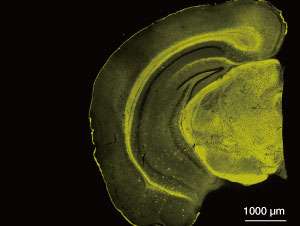The fluorescent probe, BD-Oligo, developed by A*STAR detects amyloid-beta oligomers (yellow) in an Alzheimer's disease-affected brain. Credit: A*STAR Singapore Bioimaging Consortium
A*STAR researchers have developed the first selective probe for a marker of the stage before the brain plaques which characterize Alzheimer's disease are formed.
Alzheimer's, which affects approximately 35 million people worldwide, is a neurodegenerative disease in which aggregates or plaques are formed by a protein called amyloid-beta. An A*STAR team has developed the first selective probe for amyloid-beta oligomers, the intermediate stage before plaque formation, and a promising AD biomarker.
"Amyloid plaques are the hallmarks of Alzheimer's disease," explains Chang Young-Tae from the A*STAR Singapore Bioimaging Consortium, "however there were doubts that they were a good biomarker for diagnosis," he says. "You can't tell much about the real situation of the disease—so people looked for other markers, such as the oligomer." Oligomers are now generally believed to be the species responsible for Alzheimer's disease pathogenesis.
An oligomer is an intermediate formed during the aggregation of amyloid-beta monomers into long fibrils and eventually plaques. "An oligomer is really a dynamic state," explains Chang, "it can go back to a monomer state or can move to the aggregate state, that's the real difficulty of studying oligomers".
To understand the progression from an oligomer through to a fibril, and the development of Alzheimer's disease, scientists needed a probe that would be highly visible, sensitive and selective. It would also need to be able to cross the blood-brain barrier. Chang Young-Tae and Teoh Chai Lean combed through the diversity-oriented fluorescence library (DOFL)—an in-house synthesized collection of 10,000 fluorescent molecules—to find a probe that would satisfy these criteria.
After testing 3,500 DOFL compounds, they found BoDipy-Oligomer, known as 'BD-Oligo'. This showed a stronger response to amyloid-beta oligomers, with the signal decreasing once a polymer started to form, which demonstrated to Chang and the team that they had found the first ever selective probe for oligomers.
With this fluorescent probe, the team was able to monitor oligomers in real time during the formation of fibrils. Additionally, in vivo tests on live mice revealed that BD-Oligo was able to cross the blood-brain barrier without any apparent toxicity.
The team patented the probe and is now focused on further developing it for in vivo or clinical applications. Chang notes there is the possibility of converting the molecule to a positron emission tomography (PET) probe which would be of greater clinical use. The development of a probe that preferentially detects amyloid-beta oligomers, rather than monomers or polymers, is promising for diagnostics aimed at detecting Alzheimer's disease in its early stages. Such a tool would improve the ability of clinicians to choose the best treatment or palliative care for patients.
More information: Chai Lean Teoh et al. Chemical Fluorescent Probe for Detection of Aβ Oligomers, Journal of the American Chemical Society (2015). DOI: 10.1021/jacs.5b06190
Journal information: Journal of the American Chemical Society





















